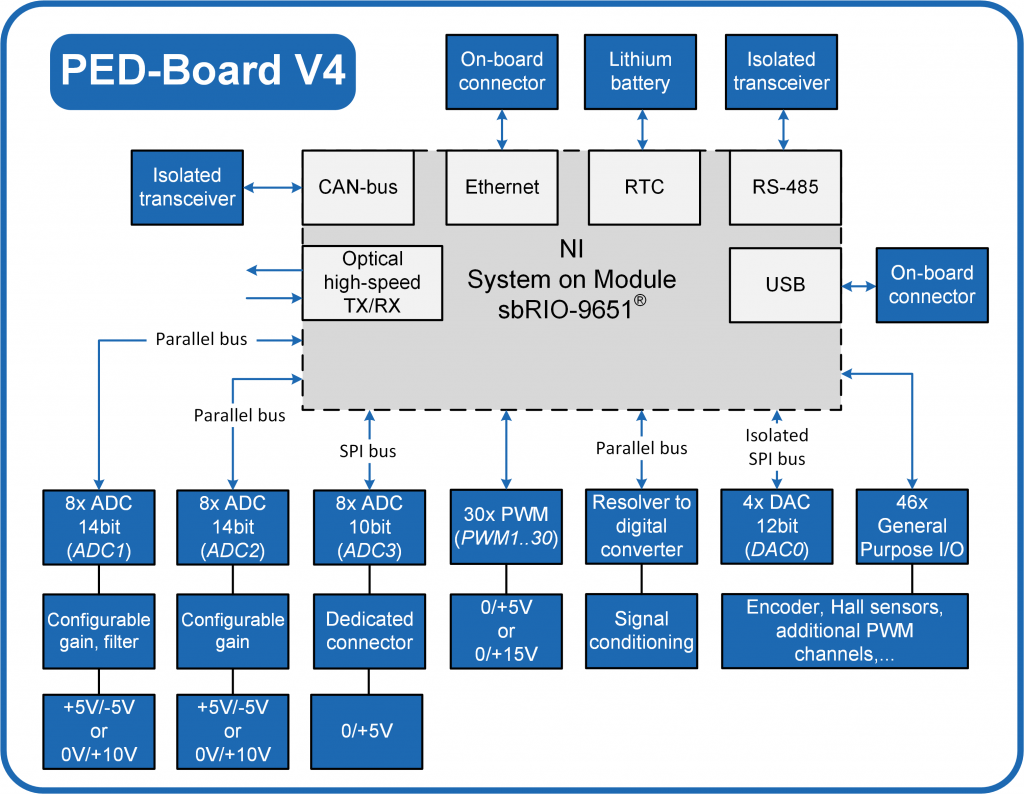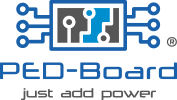PED-Board V4 (status: full production)
– PED-Board ecosystem-
A dedicated board having the specific features that cover the requirements of the Power Electronics and Drives (PED) applications. Accordingly, the PED-Board has been designed and realized to exploit the benefits of the NI SoM (formally sbRIO-9651) and LabVIEW graphical programming. PED-Board incorporates ADC, DAC, CAN-bus and many other functionalities that can cover the requirements of a typical PED project.
Proposed PED-Board can be connected to almost every power converter thanks to the application specific Adapter Board. The Adapter Board is placed on top the PED-Board providing mainly the required connections to the outer world.
PED-Board is the right companion for the so-called software-defined PED application
One board, specific software…a world of possibilities

FUNCTIONAL BLOCK DIAGRAM
FEATURES
30 x PWM channels
- 0÷15 V or 0÷5V selectable voltage swing
- Direct LED driving capability for optocoupled gate driver
- Additional PWM channels available through the Digital I/O interface
14-bit ADC, 8 Channels
- Simultaneous sampling
- -5/+5V or 0/10V selectable input
- 1.45 μs conversion time, 8 channels
- Differential input
- Configurable gain (each channel)
- Second order low-pass Butterworth active filter with
configurable cut-off frequency (default 20kHz)
14-bit ADC, 8 Channels
- Simultaneous sampling
- -5/+5V or 0/10V selectable input
- 1.45 μs conversion time, 8 channels
- Differential input
- Configurable gain (each channel)
10-bit ADC, 8 Channels
- Up to 200 kS/s
- Single-ended input, 0/+5V
12-bit DAC, 4 Channels
- Digital-to-analog converter with 5 μs settling-time
- Isolated, no ground loops
TX/RX optical link
Resolver interface
- Fully configurable electrical interface
- Speed and position measurement
- Resolver fault detection
46 x Digital I/O
- Hall-effect position sensors interface
- Encoder interface
- Relay control
- Additional PWM
- General purpose I/O
1 x 10/100/1000 base-T Ethernet port
- Auto-negotiated, half/full-duplex
- Programming, debugging and operation
1 x RS-485
- Isolated transceiver
- Half-duplex and full-duplex communication
- On-board terminator resistor
1 x CAN-bus
- 2.0A and 2.0B support, up to 1 Mbit/s
- Isolated transceiver
- On-board terminator resistor
USB port
Lithium battery for the Real-Time clock
Dedicated LabVIEW drivers and demo programs have been developed to completely support the user in the application software design stage. Each peripheral is fully supported by the LabVIEW CLIP and/or a specific VI. Kernel programs are available for users with properly designed FPGA main scheduler, Real-Time target tasks, synchronization etc…
